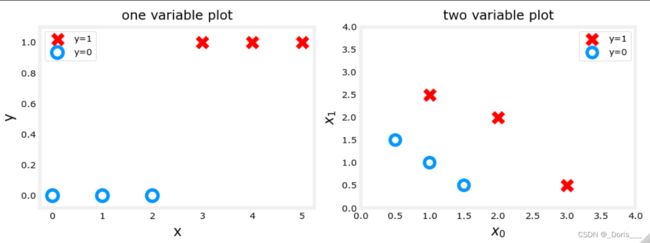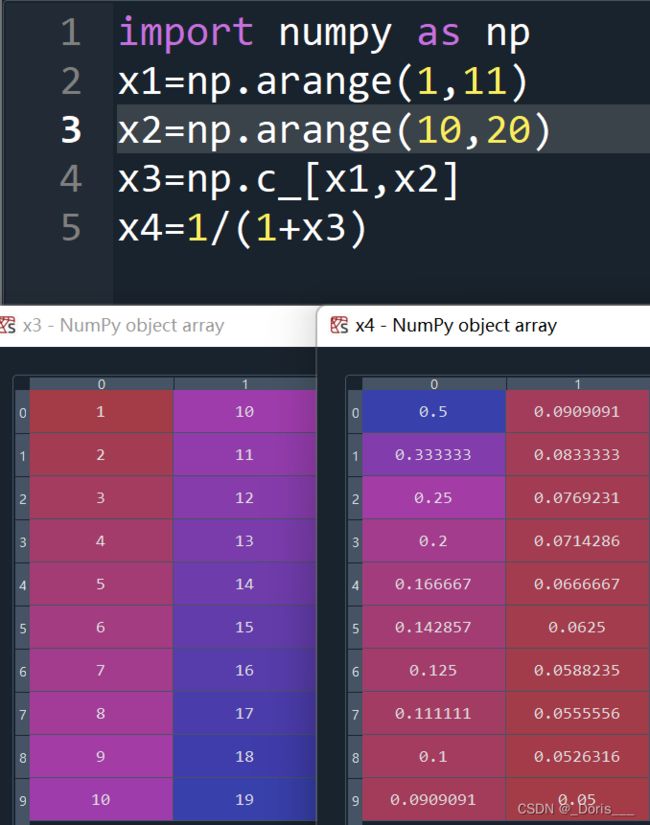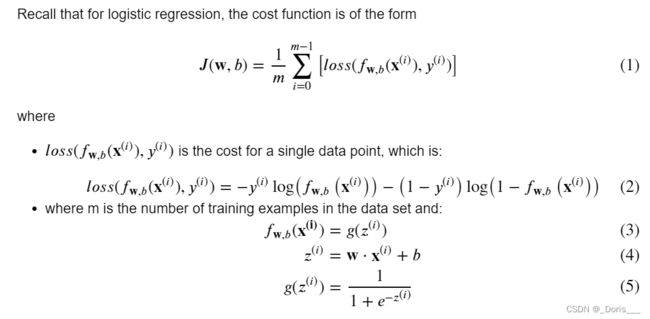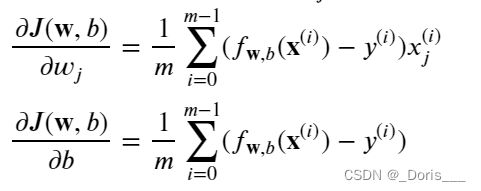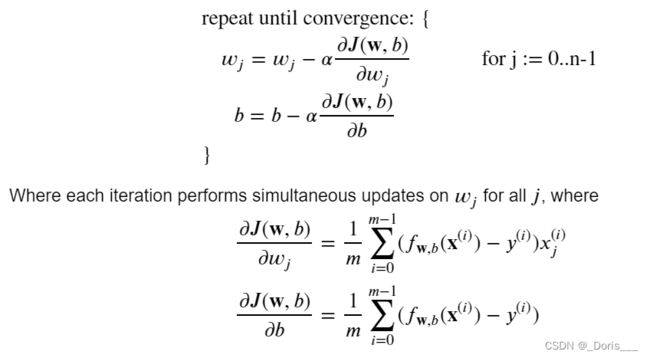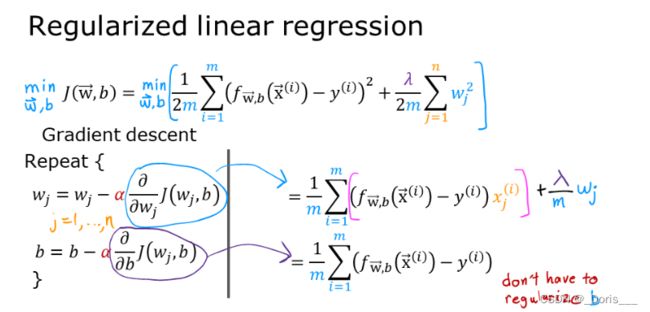监督学习week 3: Logistic Regression optional_lab收获记录
目录
1.技巧one:利用布尔索引分别去画图
2.注意:有关numpy
3.课程中define的loss和cost区别:
4.Cost Function for Logistic Regression
5.compute_gradient_logistic
6.Gradient Descent
7.Logistic Regression using Scikit-Learn
① Dataset
②Fit the model
③Make Predictions
④Calculate accuracy
8.To avoid the overfitting->Regularized Cost and Gradient Goals
①theory and formula编辑
②Cost functions with regularization
③Gradient descent with regularization编辑
1.技巧one:利用布尔索引分别去画图
x_train = np.array([0., 1, 2, 3, 4, 5])
y_train = np.array([0, 0, 0, 1, 1, 1])
X_train2 = np.array([[0.5, 1.5], [1,1], [1.5, 0.5], [3, 0.5], [2, 2], [1, 2.5]])
y_train2 = np.array([0, 0, 0, 1, 1, 1])
pos = y_train == 1 #positive->注意:本处采用的是bool索引
neg = y_train == 0 #negeative
fig,ax = plt.subplots(1,2,figsize=(8,3))
#plot 1, single variable
ax[0].scatter(x_train[pos], y_train[pos], marker='x', s=80, c = 'red', label="y=1")
ax[0].scatter(x_train[neg], y_train[neg], marker='o', s=100,
label="y=0", facecolors='none', edgecolors=dlc["dlblue"],lw=3)
ax[0].set_ylim(-0.08,1.1)
ax[0].set_ylabel('y', fontsize=12)
ax[0].set_xlabel('x', fontsize=12)
ax[0].set_title('one variable plot')
ax[0].legend()
#plot 2, two variables
plot_data(X_train2, y_train2, ax[1])
ax[1].axis([0, 4, 0, 4])
ax[1].set_ylabel('$x_1$', fontsize=12)
ax[1].set_xlabel('$x_0$', fontsize=12)
ax[1].set_title('two variable plot')
ax[1].legend()
plt.tight_layout()
plt.show()2.注意:有关numpy
①一维数组的C_按列连接
②1/1+z(当z为矩阵的时候,运算的情况,依次对于每一个数都会进行操作)
③NumPy has a function called exp(), which offers a convenient way to calculate the exponential ( ez) of all elements in the input array (
z).
3.课程中define的loss和cost区别:
Definition Note: In this course, these definitions are used:
Loss is a measure of the difference of a single example to its target value while the
Cost is a measure of the losses over the training set
4.Cost Function for Logistic Regression
Note that the variables X and y are not scalar values but matrices of shape (,m,n) and (,) respectively, where is the number of features and is the number of training examples.
def compute_cost_logistic(X, y, w, b): """ Args: X (ndarray (m,n)): Data, m examples with n features y (ndarray (m,)) : target values w (ndarray (n,)) : model parameters b (scalar) : model parameter""" m = X.shape[0] cost = 0.0 for i in range(m): z_i = np.dot(X[i],w) + b f_wb_i = sigmoid(z_i) cost += -y[i]*np.log(f_wb_i) - (1-y[i])*np.log(1-f_wb_i) cost = cost / m return cost
5.compute_gradient_logistic
def compute_gradient_logistic(X, y, w, b): """ Args: X (ndarray (m,n): Data, m examples with n features y (ndarray (m,)): target values w (ndarray (n,)): model parameters b (scalar) : model parameter Returns dj_dw (ndarray (n,)): The gradient of the cost w.r.t. the parameters w. dj_db (scalar) : The gradient of the cost w.r.t. the parameter b. """ m,n = X.shape dj_dw = np.zeros((n,)) #(n,) dj_db = 0. for i in range(m): f_wb_i = sigmoid(np.dot(X[i],w) + b) #(n,)(n,)=scalar err_i = f_wb_i - y[i] #scalar for j in range(n): dj_dw[j] = dj_dw[j] + err_i * X[i,j] #scalar dj_db = dj_db + err_i dj_dw = dj_dw/m #(n,) dj_db = dj_db/m #scalar return dj_db, dj_dw
6.Gradient Descent
def gradient_descent(X, y, w_in, b_in, alpha, num_iters): """ Args: X (ndarray (m,n) : Data, m examples with n features y (ndarray (m,)) : target values w_in (ndarray (n,)): Initial values of model parameters b_in (scalar) : Initial values of model parameter alpha (float) : Learning rate num_iters (scalar) : number of iterations to run gradient descent Returns: w (ndarray (n,)) : Updated values of parameters b (scalar) : Updated value of parameter """ J_history = [] # for graphing later w = copy.deepcopy(w_in) #avoid modifying global w within function b = b_in for i in range(num_iters): dj_db, dj_dw = compute_gradient_logistic(X, y, w, b) # Calculate the gradient and update the parameters w = w - alpha * dj_dw # Update Parameters using w, b, alpha and gradient b = b - alpha * dj_db if i<100000: # prevent resource exhaustion J_history.append( compute_cost_logistic(X, y, w, b) ) # Save cost J at each iteration if i% math.ceil(num_iters / 10) == 0: print(f"Iteration {i:4d}: Cost {J_history[-1]} ") # Print cost every at intervals 10 times or as many iterations if < 10 return w, b, J_history #return final w,b and J history for graphing
7.Logistic Regression using Scikit-Learn
① Dataset
import numpy as np X = np.array([[0.5, 1.5], [1,1], [1.5, 0.5], [3, 0.5], [2, 2], [1, 2.5]]) y = np.array([0, 0, 0, 1, 1, 1])②Fit the model
The code below imports the logistic regression model from scikit-learn. You can fit this model on the training data by calling
fitfunction.from sklearn.linear_model import LogisticRegression lr_model = LogisticRegression() lr_model.fit(X, y)③Make Predictions
see the predictions made by this model by calling the
predictfunction.y_pred = lr_model.predict(X) print("Prediction on training set:", y_pred)Prediction on training set: [0 0 0 1 1 1]④Calculate accuracy
calculate this accuracy of this model by calling the
scorefunction.print("Accuracy on training set:", lr_model.score(X, y))Accuracy on training set: 1.0
8.To avoid the overfitting->Regularized Cost and Gradient Goals
①theory and formula
②Cost functions with regularization
(i)Cost function for regularized linear regression
不惩罚b
def compute_cost_linear_reg(X, y, w, b, lambda_ = 1): """ Args: X (ndarray (m,n): Data, m examples with n features y (ndarray (m,)): target values w (ndarray (n,)): model parameters b (scalar) : model parameter lambda_ (scalar): Controls amount of regularization Returns: total_cost (scalar): cost """ m = X.shape[0] n = len(w) cost = 0. for i in range(m): f_wb_i = np.dot(X[i], w) + b #(n,)(n,)=scalar, see np.dot cost = cost + (f_wb_i - y[i])**2 #scalar cost = cost / (2 * m) #scalar reg_cost = 0 for j in range(n): reg_cost += (w[j]**2) #scalar reg_cost = (lambda_/(2*m)) * reg_cost #scalar total_cost = cost + reg_cost #scalar return total_cost(ii)Cost function for regularized logistic regression
def compute_cost_logistic_reg(X, y, w, b, lambda_ = 1): """Args: X (ndarray (m,n): Data, m examples with n features y (ndarray (m,)): target values w (ndarray (n,)): model parameters b (scalar) : model parameter lambda_ (scalar): Controls amount of regularization Returns:total_cost (scalar): cost """ m,n = X.shape cost = 0. for i in range(m): z_i = np.dot(X[i], w) + b #(n,)(n,)=scalar, see np.dot f_wb_i = sigmoid(z_i) #scalar cost += -y[i]*np.log(f_wb_i) - (1-y[i])*np.log(1-f_wb_i) #scalar cost = cost/m #scalar reg_cost = 0 for j in range(n): reg_cost += (w[j]**2) #scalar reg_cost = (lambda_/(2*m)) * reg_cost #scalar total_cost = cost + reg_cost #scalar return total_cost #scalar③Gradient descent with regularization
(i) for regularized linear regression
def compute_gradient_linear_reg(X, y, w, b, lambda_): """ Args: X (ndarray (m,n): Data, m examples with n features y (ndarray (m,)): target values w (ndarray (n,)): model parameters b (scalar) : model parameter lambda_ (scalar): Controls amount of regularization Returns: dj_dw (ndarray (n,)): The gradient of the cost w.r.t. the parameters w. dj_db (scalar): The gradient of the cost w.r.t. the parameter b. """ m,n = X.shape #(number of examples, number of features) dj_dw = np.zeros((n,)) dj_db = 0. for i in range(m): err = (np.dot(X[i], w) + b) - y[i] for j in range(n): dj_dw[j] = dj_dw[j] + err * X[i, j] dj_db = dj_db + err dj_dw = dj_dw / m dj_db = dj_db / m for j in range(n): dj_dw[j] = dj_dw[j] + (lambda_/m) * w[j] return dj_db, dj_dw(ii)for regularized logistic regression
def compute_gradient_logistic_reg(X, y, w, b, lambda_): """Args: X (ndarray (m,n): Data, m examples with n features y (ndarray (m,)): target values w (ndarray (n,)): model parameters b (scalar) : model parameter lambda_ (scalar): Controls amount of regularization Returns dj_dw (ndarray Shape (n,)): The gradient of the cost w.r.t. the parameters w. dj_db (scalar) : The gradient of the cost w.r.t. the parameter b. """ m,n = X.shape dj_dw = np.zeros((n,)) #(n,) dj_db = 0.0 #scalar for i in range(m): f_wb_i = sigmoid(np.dot(X[i],w) + b) #(n,)(n,)=scalar err_i = f_wb_i - y[i] #scalar for j in range(n): dj_dw[j] = dj_dw[j] + err_i * X[i,j] #scalar dj_db = dj_db + err_i dj_dw = dj_dw/m #(n,) dj_db = dj_db/m #scalar for j in range(n): dj_dw[j] = dj_dw[j] + (lambda_/m) * w[j] return dj_db, dj_dw
